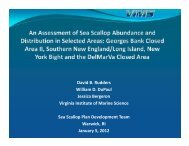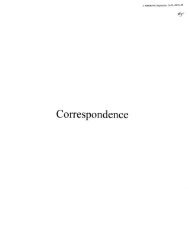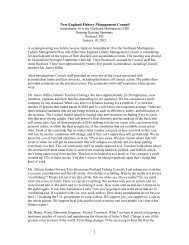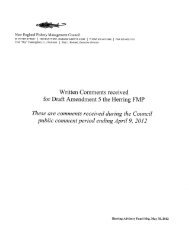Smooth Bottom Net Trawl Fishing Gear Effect on - New England ...
Smooth Bottom Net Trawl Fishing Gear Effect on - New England ...
Smooth Bottom Net Trawl Fishing Gear Effect on - New England ...
Create successful ePaper yourself
Turn your PDF publications into a flip-book with our unique Google optimized e-Paper software.
NOAA/NMFS Unallied Science Project, Cooperative Agreement NA16FL2264 December 2005<br />
<str<strong>on</strong>g>Smooth</str<strong>on</strong>g> <str<strong>on</strong>g>Bottom</str<strong>on</strong>g> <str<strong>on</strong>g>Net</str<strong>on</strong>g> <str<strong>on</strong>g>Trawl</str<strong>on</strong>g> <str<strong>on</strong>g>Fishing</str<strong>on</strong>g> <str<strong>on</strong>g>Gear</str<strong>on</strong>g> <str<strong>on</strong>g>Effect</str<strong>on</strong>g> <strong>on</strong> the Seabed:<br />
Investigati<strong>on</strong> of Temporal and Cumulative <str<strong>on</strong>g>Effect</str<strong>on</strong>g>s BKAM/CR<br />
supports the c<strong>on</strong>clusi<strong>on</strong> that trawling did not result in any appreciable changes in<br />
sediment physical or biological characteristics, to the extent such changes could be<br />
determined through repeated sediment-profile imaging surveys.<br />
3.5.4 Sediment Profile Imaging Discussi<strong>on</strong> (D<strong>on</strong>ald C. Rhoads)<br />
3.5.4.1 Physical evidence of trawling impacts<br />
The REMOTS® survey of 2002 did not detect any clear difference between the two<br />
trawled sites and their respective c<strong>on</strong>trol areas (Little Tow and Mud Hole). The<br />
sediment-profile images show that, within the small field-of-view provided by the<br />
camera, (ca. 13 cm wide and ca. 20 cm high), the sediment-water interface is dominated<br />
by biogenic roughness (feeding mounds, pits, etc) rather than physically induced<br />
roughness such as door furrows, net sweep, erosi<strong>on</strong>, or physical mounding. Ecologically<br />
significant gear impacts would be expected to result in significant surface erosi<strong>on</strong><br />
removing all, or part, of the surface oxidized z<strong>on</strong>e as well as exhumati<strong>on</strong> and/or burial of<br />
near surface –dwelling infauna. Such erosi<strong>on</strong> produces anomalously thin apparent RPD<br />
z<strong>on</strong>es relative to the ambient bottom and exposes reduced sediment to the sediment-water<br />
interface.<br />
Larger scale panoramic imaging survey systems used in this study (i.e. side-scan s<strong>on</strong>ar<br />
and ROV videos) clearly show the presence of plowed furrows related to the passage of<br />
trawl doors al<strong>on</strong>g the bottom. It is highly likely that random deployment of the<br />
REMOTS® optical system at <strong>on</strong>ly 6 stati<strong>on</strong>s (with 3 replicates per stati<strong>on</strong>) in the trawled<br />
areas did not sample the trawl door furrows and associated lateral mounds. It is likely<br />
however, that these REMOTS® stati<strong>on</strong>s either were located in “c<strong>on</strong>trol-like” areas of the<br />
bottom not affected by recent trawling or were located in areas that were passed over by<br />
the ground cables and trailing net (i.e. “cookies” and net sweep). If the latter case is true,<br />
the passage of the ground cables/net did not leave a disturbance signature that could be<br />
detected by high resoluti<strong>on</strong> REMOTS® imagery.<br />
3.5.4.2 Biological evidence of chr<strong>on</strong>ic bottom disturbance<br />
The Organism Sediment Index (OSI), calculated from the comp<strong>on</strong>ent REMOTS®<br />
parameters, has empirically proven to be a sensitive indicator of existing or past bottom<br />
disturbance based <strong>on</strong> REMOTS® surveys c<strong>on</strong>ducted in a variety of marine habitats<br />
around the world over the past two decades. The overall populati<strong>on</strong> means for OSIs at<br />
Little Tow and Mud Hole trawled sites range from 5.3 t0 5.7 and the OSI values for the<br />
c<strong>on</strong>trol sites range from 5.4 to 6.2 (Valente and Pinckard (2003). Experience has shown<br />
that OSI values of +6 or greater tend to be associated with low level or infrequent<br />
physical/chemical impacts while values less than +6 tend to be associated with impacted<br />
areas. Severely impacted areas yield OSIs that are negative. No negative OSIs were<br />
measured in this study, Mean values for both trawled and c<strong>on</strong>trol areas are comparable in<br />
value being just below the +6 threshold criteri<strong>on</strong>. This suggests that the ambient system<br />
is experiencing a low level of ambient disturbance. Results of the side-scan and ROV<br />
surveys show that parts of the bottom are rippled indicating that bottom currents are<br />
54







